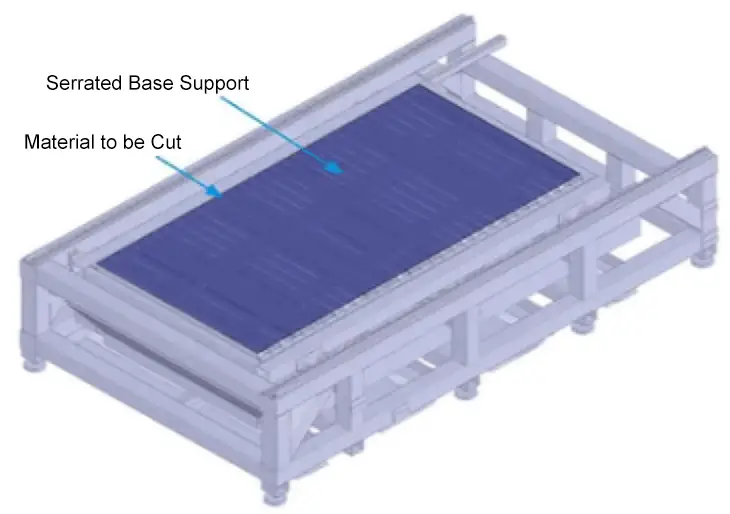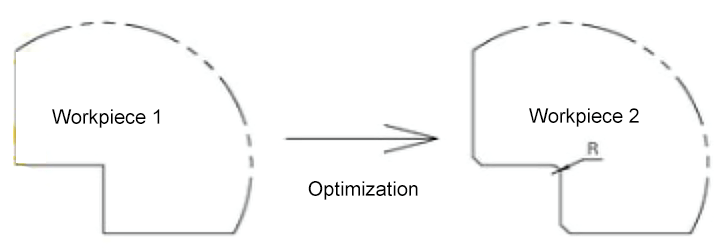Laser cutting focuses a laser beam onto the surface of a material using a focusing lens. This causes the material to melt, vaporize and burn.
At the same time, a compressed gas coaxial with the laser beam blows away the molten material.
By moving the laser beam in relation to the material along a specific trajectory, a cut with a specific shape is made, achieving cutting of the material.
Laser cutting offers advantages such as high precision, narrow cutting, smooth cutting surfaces, fast speeds and superior processing quality on a wide variety of materials.
Currently, laser cutting technology is widely applied in various industries. Due to its low processing cost, high efficiency and versatility in material processing, laser cutting has become a common method in the sheet metal industry.
However, there are challenges such as molten slag and burrs adhering to the material during processing, causing problems for on-site managers. The piece's burrs are illustrated in Figure 1.

Burrs in laser cutting
Burr formation is a common occurrence during laser cutting machine processing and remains an unsolved problem in metal cutting theory.
Burr affects the dimensional accuracy, shape and positional accuracy, as well as the surface roughness of the machined part. Today we will discuss the common causes of burrs in laser cutting and the solutions available.

Causes and solutions of burrs in laser cutting.
Cause 1: Shift position of laser beam focus
- Problem: The focus of the laser beam generated by the laser cutting machine presents a deviation between its upper and lower positions, meaning that the energy is not concentrated precisely on the part and causing incomplete vaporization. This leads to an increase in the amount of molten slag and the formation of burrs.
- Solution: Adjust the laser beam focus position to its ideal state based on the offset position.
Cause 2: Insufficient output power
- Problem: The laser cutting machine has insufficient output power, causing ineffective metal vaporization and leading to excessive slag and burr formation.
- Solution: Check whether the laser cutting machine is working properly. If there is any malfunction, repair and maintain it immediately. If the machine is operating normally, check whether the output value is correct.
Cause 3: Slow cutting line speed
- Problem: The cutting line speed of the laser cutting machine is too slow, leading to poor surface quality and burr formation.
- Solution: Adjust and improve the cutting line speed to reach the normal value.
Cause 4: Impure Auxiliary Gas
- Problem: The purity of the auxiliary gas used in the laser cutting machine does not meet the required standard, leading to the formation of burrs on the part.
- Solution: Replace the auxiliary gas with one of higher purity.
Cause 5: Prolonged operating time
- Problem: The laser cutting machine has been operating for a long time, making it unstable and causing burrs to form.
- Solution: Turn off the laser cutting machine and restart it after a certain period of time to allow it to rest completely.
Cause 6: Deficiencies in laser cutting equipment
For example, the sawtooth depth of the laser base sawtooth tray is shallow and its taper is insufficient, leading to excessive contact with the metal sheet.
This results in obstacles during laser drilling and blockage of gas flow, causing the molten slag to adhere, rebound, and create burrs, as shown in Figure 2.

Burrs on the edges of the part can seriously affect the accuracy of subsequent bending, welding and assembly. They also pose potential safety risks to operators.
Workpieces with burrs applied to gas cabinets in ring networks can significantly affect the tightness.
In electrical systems, burrs can cause short circuits or damage the magnetic field, affecting the normal functioning of the system or causing other damage.
Methods for preventing burrs in laser processing
1. Adjust the equipment parameters:
Depending on the material being processed, repeatedly adjust power, air pressure, flow rate, focal length and feed speed to obtain optimal conditions.
Save data for future batch processing. Relying solely on the parameters provided by the machine will not produce quality parts.
2. Select Auxiliary Gas:
The choice of auxiliary gas affects the quality of processing. Different materials require different gases.
For example, when cutting stainless steel, nitrogen is recommended. Nitrogen, often called an inert gas, not only prevents explosive spots during laser cutting, but also ensures that the heated end does not oxidize instantly, resulting in a smoother, brighter cut.
Gas purity is also essential; Always choose high purity gases.
3. Inspect equipment components:
Older equipment can produce burrs due to wear or contamination of key components. Problems such as lenses contaminated with oil stains, small cracks and damaged cutting tips can affect the transmission of laser power.
You can judge this by observing whether the light spot formed is rounded. A rounded light spot indicates even energy distribution and high cutting quality.
Regular inspection of key components can ensure cutting quality.
4. Optimize equipment structure:
Depending on the part being processed, you can improve the structure of the equipment.
For example, if the serrated tray of the laser base contacts the sheet metal over a large area and produces burrs, you can adjust based on specific circumstances by reducing the taper or increasing the depth of the tooth, as shown in Figure 3 , to avoid interference with processing.

The improved base is shown in Figure 4.

5. Optimize part edges:
In real production, it is observed that excessively structured edges of the part affect the processing quality. Square transitions, compared to rounded or chamfered ones, are more prone to burrs, as shown in Figure 5.

It is advisable to use rounded or chamfered transitions when possible to reduce stress concentrations.
Conclusion
In fact, burrs are excessive residual particles on the surface of metal materials.
When the laser cutting machine processes a workpiece, the energy generated by the laser beam radiating the surface of the workpiece causes the surface to vaporize and evaporate, achieving the purpose of cutting.
If a material has burrs, it may be considered substandard; the more burrs there are, the lower the quality.
Therefore, we must pay extra attention to this issue during future processing!

























































